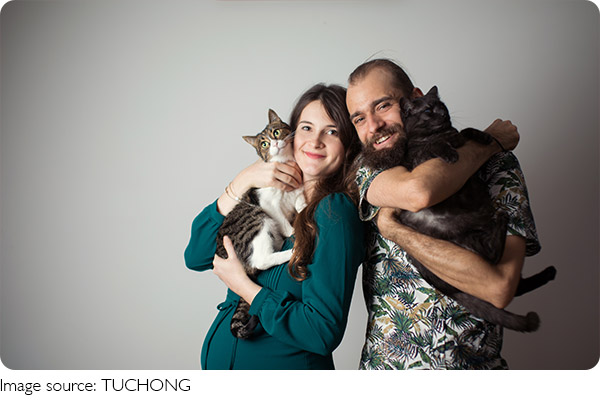Decode Your Pet's Emotions

Reading body language is essential because pets don't use words to tell us how they feel. They express joy, anxiety, discomfort, and excitement using posture, movement, and vocal cues.
According to the American Veterinary Medical Association, recognizing these signs can reduce misunderstandings and improve both the emotional and physical health of your pet.
For example, missing early signs of stress might result in behavioral issues or even health complications.
Understanding body language also helps you adjust your actions. When you know your pet is overwhelmed, you can give them space, or if they're eager to play, you can engage them meaningfully. It creates a more respectful, peaceful coexistence at home.
Common Signs in Dogs: Ears, Tails, and More
Dogs are incredibly expressive. Most people notice tail wagging, but not all wagging means happiness. A slow wag with a stiff body often signals uncertainty or alertness. A high, fast wag often shows excitement, while a low, loose wag typically indicates calm happiness.
Other cues include:
• Ears pinned back: Nervousness or fear
• Avoiding eye contact or turning head: Submissiveness or discomfort
• Showing belly with tense muscles: Appeasement, not necessarily trust
• Yawning or licking lips (outside mealtime): Anxiety or overstimulation
To understand your dog accurately, observe the entire body, not just one feature.
What Cats Are Telling You With Their Tails and Eyes
Cats communicate with more subtlety than dogs, but their cues are just as rich. Tail position is one of the clearest indicators of their mood:
• Tail upright with a gentle curve at the top: Friendly and relaxed
• Tail puffed up: Fear or aggression
• Tail swishing quickly: Irritation or focused excitement (like during hunting play)
Other signs include:
• Slow blinking: Trust and affection
• Ears turned sideways or back: Uncertainty or annoyance
• Flattened ears and crouching: Defensive posture, possibly fear
When your cat offers you a slow blink, try returning it—it's their version of a warm smile!
Small Pets: Rabbits, Cavies, and Others
Smaller animals like rabbits and cavies also express themselves physically. Rabbits may "binky" (leap into the air) when joyful, or stomp their feet as a warning. Cavies squeak when excited, purr when content, and freeze when frightened.
Watch for:
• Rabbits thumping hind legs: Alert or stressed
• Cavies making high-pitched squeals: May be hungry, excited, or scared
• Hamsters baring teeth or standing tall: Defensive behavior
Providing hideouts and quiet spaces helps these animals feel safe, which improves their comfort in your presence.
Birds and Reptiles: Expressive in Their Own Way
Birds can be very expressive through vocalization, feather position, and body movement. A parrot fluffing up its feathers and bobbing its head might be happy or seeking attention. However, if feathers stay puffed for long periods and the bird is quiet, it might be unwell.
Reptiles, though less obviously emotive, do communicate. A bearded dragon that turns black around the beard area is likely stressed. Rapid movements or freezing can also indicate discomfort.
Always research your pet species specifically—each one has its unique body language patterns.
How to Respond Appropriately
Recognizing signs is only half the task—how you respond makes a big difference. If your pet is anxious:
• Give them space
• Avoid loud noises or fast movements
• Use a calm voice
• Remove stressors from their environment
If they're excited:
• Engage in interactive play
• Offer safe toys
• Reinforce positive behavior with gentle rewards
Responding with empathy builds trust and makes training easier and more effective.
Consistency and Observation Are Key
No two pets are exactly the same. Some dogs may wag their tails more than others; some cats may rarely vocalize. What matters most is your consistency in observing their behavior and learning their "normal."
Keep a mental or written note of:
• Daily behavior patterns
• Triggers for excitement or fear
• Physical changes (e.g., posture, fur, eyes)
This helps you detect subtle emotional shifts and catch early signs of discomfort or illness.

Final Thought: It's a Two-Way Relationship
Your pet is constantly watching and learning from you too. Just as you're learning to interpret their body language, they're learning what your gestures and tones mean. Mutual understanding builds lasting bonds.
Have you noticed a unique signal your pet uses to get your attention or express a feeling? Share your story—your insight could help another pet parent!
Want to understand your pet better? Begin by watching, listening, and responding. Every pet speaks a silent language—you just need to start the conversation.
-
 Great Barrier Reef Day TripThis Hidden Trick Makes Your Great Barrier Reef Tour 10x More Magical!
Great Barrier Reef Day TripThis Hidden Trick Makes Your Great Barrier Reef Tour 10x More Magical! -
 Pyramids Travel GuideInsider Secrets: Make Your Visit to Egypt's Giza Pyramids Truly Unforgettable in 2025!
Pyramids Travel GuideInsider Secrets: Make Your Visit to Egypt's Giza Pyramids Truly Unforgettable in 2025! -
 Gold: Crisis PreparednessThis Ancient Metal Could Save Your Portfolio When Everything Else Crashes - Financial Pros Reveal Why!
Gold: Crisis PreparednessThis Ancient Metal Could Save Your Portfolio When Everything Else Crashes - Financial Pros Reveal Why!